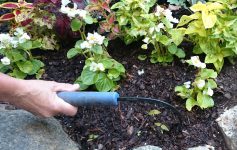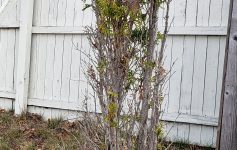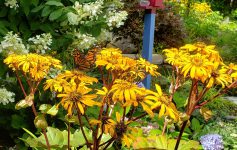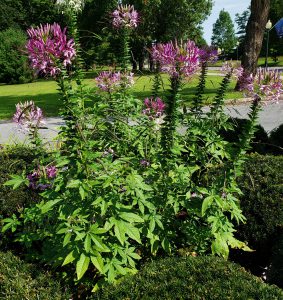 Have you considered the value of plants that reseed themselves when designing your sustainable garden? Over the years I have used a variety of annuals and perennials to meet the needs of problematic sites. I have also found value in overall garden designs. Fall is a good time to check out your garden for reseeding potential.
Have you considered the value of plants that reseed themselves when designing your sustainable garden? Over the years I have used a variety of annuals and perennials to meet the needs of problematic sites. I have also found value in overall garden designs. Fall is a good time to check out your garden for reseeding potential.
What are re seeders?
Re seeders are annual and perennial plants that develop seeds this time of year. Once the seeds ripen and turn brown, these seed heads split open. These seed capsules can be used to reproduce that plant next year. You can scatter the seeds wherever you would like them to grow, or as I do, just let them drop where they are! By next spring, you will have seedlings emerging.
How do I assure my re seeders grow next spring?
To assure success I recommend the following:
- make sure your fall garden shutdown includes removing any weeds in the beds. This will help you discern the seedling from the weeds that emerge in the spring
- apply your fall garden fertilizer to promote seed and root growth
- top dress your garden beds with organic mulch in the spring to give a good soil medium for the seedlings to sprout
- apply your spring fertilizer to enhance growth
What annuals reseed well in our region?
I have used many annuals with the specific intend to give me a return on my investment. My favorite is the cleome. I began using this as a way to manage weeds at a garden site that lacks adequate lawn management. The perimeter lawns were not routinely mowed. So the weed seeds became increasingly problematic in the beds. Cleome really helped with this problem. I allowed the seeds to drop in the fall and scattered the seed capsules in areas I wanted to increase their presence next season.
Alyssum is another great border plant that will reseed given the proper environment. Follow the preceding tips to assure that they return. I have also found that winter snow cover is a bonus for re seeders like alyssum. With good snow cover in the winter, re seeders have a better chance of reappearing in the spring. That extra insulation really helps. Other annual re seeders include: calendula ( a real butterfly treat), verbena and bachelor buttons.
What perennials reseed well n our region?
I use my perennial re seeders to supplement my gardens. I have used columbine for years in my shady areas. Another part shade perennial less known for its reseeding value is the Bottle Rocket ligularia.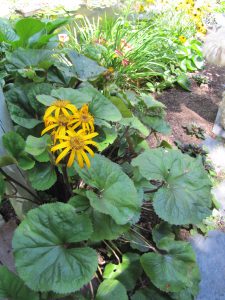 I call this my garden “drama queen”. It is a real asset this time of year when other plants are at the end of their blooming cycle. Other commonly known perennials that do well here are pansies, coreopsis, coneflowers, black eyed Susan and New England asters. The trick with the perennials is to leave the seed heads in the garden for the winter. These are perennials I choose not to cut back/deadhead to reap the benefit of their seeds next season.
I call this my garden “drama queen”. It is a real asset this time of year when other plants are at the end of their blooming cycle. Other commonly known perennials that do well here are pansies, coreopsis, coneflowers, black eyed Susan and New England asters. The trick with the perennials is to leave the seed heads in the garden for the winter. These are perennials I choose not to cut back/deadhead to reap the benefit of their seeds next season.
You can also help your biennials (those perennials that bloom every other year) come back annually. These include foxglove, hollyhocks and forget me nots. The first year the plant will not produce bl0oom just leaves. But by year 2 you will see a bloom. So your reseeding allows you to cycle the plant to emerge annually versus biennially.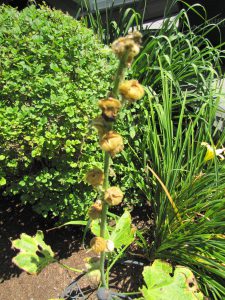 (holly hock seed heads) Word of warning: you may be surprised at the power of the reseeding. It is important that you thin your seedlings. They can overtake other garden plants if not kept in check.
(holly hock seed heads) Word of warning: you may be surprised at the power of the reseeding. It is important that you thin your seedlings. They can overtake other garden plants if not kept in check.
If you don’t have re seeders in this season’s garden, consider adding them for sustainability next year. As always, “keeping my garden practices rooted in common sense and sustainability”. For more garden topics check out my website http://gardengodesssenseandsustainabilitycom

